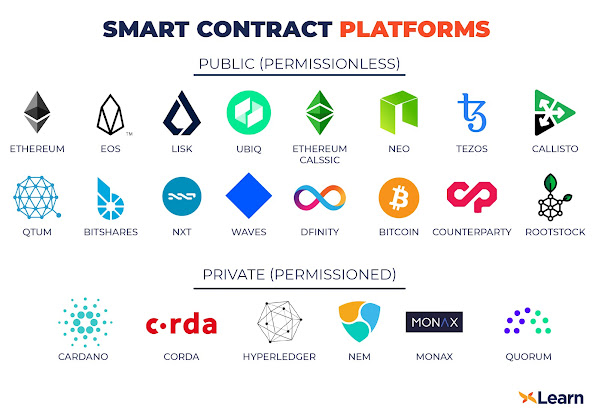
Here are some of the blockchain smartcontract development platform list and explained about it concisely:
Ethereum
Due to its peak in popularity, Ethereum is currently in second position on the cryptocurrency market and practically rules the field of smartcontracts. Ethereum will be at the core of everything if decentralisation and Dapps start to dominate the current world.
The Ethereum Virtual Machine (EVM), a comprehensive 256-bit virtual machine that is strong but easy to use, is responsible for the Ethereum smart contract functionality. The Ethereum smartcontract's use of the solidity programming language is another noteworthy feature. The ERC20 token smartcontract, ERC721 smartcontract, ERC1400 smartcontract, and other Ethereum standards are just a few examples of how this smartcontract might be created.
Hyperledger
The Linux foundation introduced Ethereum, and Hyperledger is the next in line. This hyperledger has a number of frameworks, including hyperledger burrow, hyperledger fabric, hyperledger sawtooth, and hyperledger indy.
The fact that many programming languages may be used to create a smart contract on this platform, which is open-source and supported by IBM, led developers to choose it. Both plugin modules and high performance are supported by this Hyperledger platform. Go language is used to construct smartcontracts in one of hyperledger fabric's well-known frameworks.
Cardano
Smartcontracts are also developed using this Cardano platform. Cardano's primary goal, however, is to guarantee security and, through its innovative methodology, aims to deliver great scalability. The Plutus programming language, which is based on Haskell and functions as a functional programming language on this platform, is used to create smartcontracts.
EOS
The ultimate goal of the EOS is to facilitate industrial-scale decentralised apps by becoming the hub of decentralised operating systems. The most alluring feature of this platform's promise is its ability to:
* Remove transaction fee
* Conduct millions of transactions per second
In this case, WASM language is utilised to code in this platform, which helps to boost scalability. Speed, efficiency, safety, openness, and debugability are provided by this language tool.
TRON
The TRON platform's solidity language-written smartcontract may be implemented for enterprise-grade applications in any public or private network. Due to its high performance, increased scalability, high-performance storage, compatibility with EVM, multilingual support, and transaction as PoS capabilities, this platform is widely utilised.
NEM
The NEM platform uses code written in the popular JAVA programming language, which is convenient for many developers. This common programming language feature makes it less vulnerable than other coding-based smartcontracts.
A new version of NEM has been published to enhance blockchain functionality.
NEM's Mijin v.2 upgrade strengthened the security of the NEM blockchain. Since etherum can only process about 15 transactions per second, but NEM can handle about 100 transactions per second, this functionality freed up capacity for many additional capabilities in the NEM blockchain.
Stellar
Due to its simplicity and ease of use when compared to Ethereum and NEM, Stellar is thought of as one of the best blockchain platforms to develop smartcontracts. This platform is used by many businesses since it makes international payments easier. This platform is the oldest because it was introduced in 2014, according to some sources. Later, in 2017, it worked along with IBM and KlickEx to offer a cheap way to conduct international business.
Waves
The Waves platform, which was introduced in 2016, offers a way to apply blockchain technology. Additionally, it simplifies the creation and execution of smartcontracts. Although this platform's community is still modest compared to others', it is particularly ideal for crowd sales and ICO. And even if the platform isn't very customizable, it requires the creation of tokens and smartcontracts even though there won't be much need for technical terminology. The transaction procedure on the Waves platform is extremely quick and scalable.
NEO
NEO was created by "OnChain," a blockchain R&D business with offices in Shanghai, and is also referred to as the "Ethereum of China." NEO's mission is to spread the "Smart economy" network. Digital assets, digital identity, and smartcontracts all add up to a smart economy.
The NEO platform smartcontract, commonly known as "The SmartContract 2.0," is composed of three pieces and is written in Javascript and Solidity.
They are:
- NeoVM
- InteropService
- DevPack
Tezos
Because they are written in the Michelson programming language, Tezos smartcontracts are distinctive. The Tezos project increases the security and dependability of smart contracts by employing formal verification on this platform, where the smartcontract code can be mathematically shown to adhere to specific criteria.
The unique benefit of this Tezos platform is that no specialised tools are required to construct business-oriented DApps, compilers won't be required to convert programmes into unintelligible bytecode, and it's simple to examine the smartcontract code.
Minter
The use of the Telegram Open Network's smartcontract is enabled via transactions involving the mint coin on the minter platform. A Telegram project is Telegram Open Network (TON). The TON Virtual Machine (TVM) technology is employed in TON smartcontracts, and ICOs are the primary technical instrument on this platform. Well, there are three distinct levels of language that this TON SmartContract can be written in:
They are,
- Func - a high-level smart contract language similar to C++.
- Fift - a stack-based prefix notation language.
- Fift assembly - a low-level language that Func programs are compiled to.
Counterparty
This platform incorporates data into Bitcoin transactions, i.e. it uses the cryptocurrency's blockchain and allows contracts to be developed on it.
Polkadot
It is an alternative to blockchain and is famous for its ability to host parachains, chains within chains, allowing more transactions than usual.








